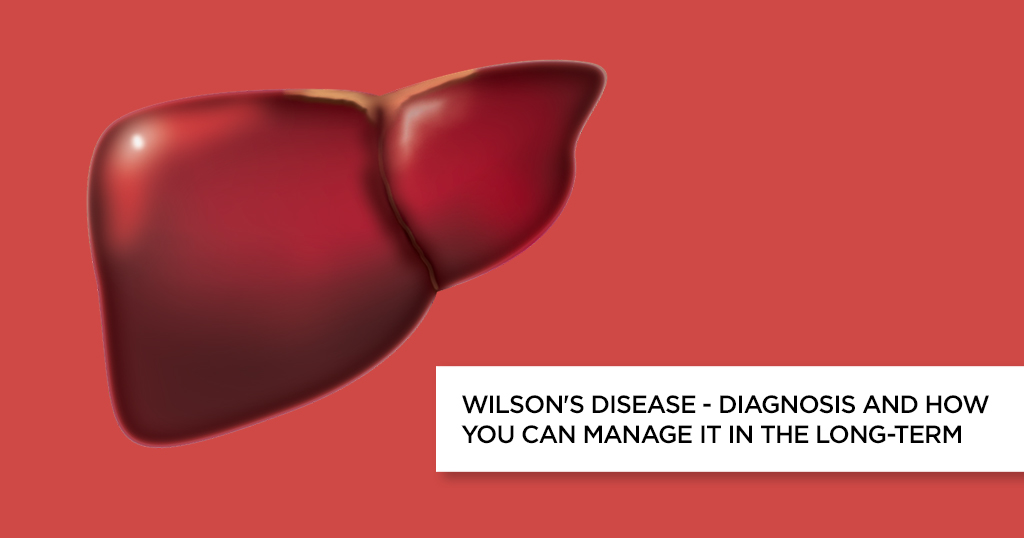Wilson’s Disease – Diagnosis and How You Can Manage it in the Long-Term


Wilson’s disease is a rare genetic disorder that is of autosomal recessive type. This is present equally in males and females. When there is a history of Wilson’s disease in the family, then there are more chances for the next generation to carry the gene in their body. Their offspring will act as either the carrier or will have the mutated ATP7B gene expression in their body.
Approximately 1 in 30,000 individuals are prone to this disease.
What is Wilson’s Disease?
Wilson’s disease is an autosomal recessive genetic disorder that leads to the accumulation of copper in the liver, brain, and vital organs. The disease is caused by a mutation in the Wilson disease protein (ATP7B) gene. Wilson disease protein carries excess copper into the bile, where it gets excreted in waste products. This disease is autosomal recessive; for an individual to be affected, he/she must inherit a mutated copy of the gene from both the parents.
Copper is important for the development of collagen, bones, skin, and nerves. When excess copper is not removed from the body, it leads to life-threatening Wilson’s disease. Mutation in the ATP7B protein (Wilson’s disease protein) results in the accumulation of copper in the liver and other organs .
Accumulation of copper in the liver reduces the functioning and leads to liver cirrhosis. Copper gets accumulated in the liver and brain. Accumulation of copper in the brain leads to neurological problems, and if not treated properly, it becomes fatal.
The only way to identify this disease at the early stage is through genetic screening. There is no cure for this disease, however, you can delay the onset of the disease using medications.
Symptoms of Wilson’s Disease
Wilson’s disease does not show symptoms at an early stage. Only when it predominates the liver and brain with copper, some signs and symptoms are visible. Neurological problems, liver damage, and psychiatric problems are associated with Wilson’s disease. The first symptom appears from the age to 6 to 45.
The symptoms mentioned here are common for the liver.
● Weakness
● Tiredness
● Weight loss
● Abdominal pain
● Kayser-Fleischer rings or sunflower cataract
● Jaundice
● Vomiting
● Muscle cramps
● Edema (swelling of legs and abdomen)
● Lack of physical coordination
● Spider angiomas (visible blood vessels on the skin)
Sometimes psychiatric problems are seen associated at the early stage like mood swings and personality change. The symptoms related to the brain are:
● Vision impairment
● Mood swings
● Depression
● Drooling
● Change in personality
● Irregular walking phase
● Migraine
At an advanced stage, problems related to the muscular system like muscle cramps, pain, and seizures may be evident . Other symptoms include:
● Kidney stones – Frequent kidney stones and pain on the lower abdomen
● Osteoporosis – Weakening of the bones
● Arthritis
Diagnosis of Wilson’s Disease
Doctors perform several tests to confirm the disease. The tests include:
● Eye examination – Slit-lamp examination of the eyes for Kayser-Fleischer rings or sunflower cataract is performed. The presence of the above conditions is an indication of Wilson’s disease.
● Liver biopsy – Drawing a small sample of liver tissue from the liver and testing it in the lab for the presence of scars is termed as liver biopsy. A liver biopsy can confirm Wilson’s disease.
● Blood tests – The amount of ceruloplasmin, and copper in the blood is analyzed in the blood test. If the concentration of ceruloplasmin is very low, and copper is very high, then the doctor can confirm the presence of Wilson’s disease.
● Urine test – The amount of copper excreted in the urine for 24 hours is examined.
● Genetic test – Analysis of the DNA for the presence of a mutation in the ATP7B gene is performed through the PCR test. Screening the family members will help too in the diagnosis of Wilson’s disease.
Complications of Wilson’s Disease
Complications of Wilson’s disease include:
● Liver failure – The functions of the liver reduces gradually and leads to acute liver failure. In this case, liver transplantation is necessary.
● Liver cirrhosis – The scarring of the liver is termed as liver cirrhosis. Liver cells get damaged by the excess concentration of copper in the liver. When the liver tries to repair the worn-out cells, it leads to excessive damage and creates scars. These scars reduce the function of the liver.
● Kidney problems – Kidney stones, and a higher concentration of amino acids in urine are some of the abnormalities found in the kidney. These conditions worsen the function of the kidney.
● Hemolysis – The destruction of red blood cells in the blood reduces the oxygen intake in the lungs. The complications associated with hemolysis are jaundice and anaemia.
● Neurological problems – Even after proper treatment, some patients will face neurological problems like involuntary muscle movements, speech difficulties, and tremors.
Treatment of Wilson’s Disease
Wilson’s disease cannot be cured and requires lifelong medication. Some of the medications used are:
● Penicillamine – Penicillamine is the chelating agent that binds with the copper and removes it from the body through urine. This is the primary medication for Wilson’s disease. Though there are side effects like joint pain and muscle pain, this is the most promising medication.
● Trientine hydrochloride – The drug trientine works similarly to penicillamine as a chelating agent and has fewer side effects. But, both medicines create neurological problems on prolonged treatment.
● Zinc acetate – helps to maintain the copper level in the blood.
● Occupational therapy – Occupational therapy is provided to patients with neurological disorders. They help to reduce the mood swings, personality changes in the body.
● Liver transplantation – This is the best way to cure Wilson’s disease. If medical treatment becomes ineffective, liver transplantation is the only way to save the patient.
Frequently Asked Questions (FAQs)
1. How long can you live with Wilson’s disease?
The life expectancy of patients with Wilson disease is 40 years without treatment and with proper treatment, they can lead a normal life. Early diagnosis helps the patients to live longer.
2. Is Wilson’s disease an autoimmune disease?
No, Wilson’s disease is not an autoimmune disease, it is an autosomal recessive disorder.
© Copyright 2024. Apollo Hospitals Group. All Rights Reserved.
 +91 8069991061
Book Health Check-up
+91 8069991061
Book Health Check-up







